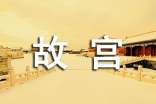故宫英文导游词
作为一名乐于为游客排忧解难的导游,常常要写一份好的导游词,导游词具有极强的实用性,涉及的知识十分广泛。怎么样才能写出优秀的导游词呢?以下是小编收集整理的故宫英文导游词,欢迎大家分享。

故宫英文导游词1
Hello, all of you, welcome to the the Imperial Palace in Beijing. I'll give you a brief introduction to the scenic spots here today. Please follow my footsteps. We are in front of the famous the Imperial Palace Museum. Well, stepped into the gate, a temple - temple we came to the Imperial Palace to the three largest Ting hall, folk known as "jinluandian". It was built in Ming Yongle for eighteen years, in 1420, and in the thirty-four years of the Qing Dynasty, Kangxi was rebuilt in 1695. How much is the height of the Taihe temple and how much area is it? Yes, it's about 35 meters tall, with an area of 2377 square meters, almost 55 classrooms, and 72 columns supporting all the weight. It's the tallest building in the the Imperial Palace. You see! Which was decorated with beautiful decoration, the middle of a throne, the throne is arranged between 6 Panlong Kim, to highlight the status of the emperor overweening. The Jiulong throne is made of gold from the nanmu Carving Dragon, and it is fine. Everyone goes right together, and the front comes to the hall of neutralization. The plane and Temple Square, yellow glazed four cuanjian Ding, can be sent! Do you know that? When the emperor is here, marking the play book offering pro. All of us go along with me, the most prominent in this space is the stone carving of Yunlong. This is the largest stone carving in the the Imperial Palace. The stone length is 16. 57 meters, 3 wide. 07 meters, 1 thick. 7 meters, weighing up to more than 200 tons! You can take a closer look at a look around the stone, engraved with lotus pattern, the lower water Jiang Ya, intermediate carved with nine dragons and foil Cloud State dragon, Yunlong true to life, fine carving.
This is the end of today's explanation, and you can visit it by yourself. I want to remind you: notice that anything can never be touched by hand in order to protect the rare relics. We'll gather here in 20 minutes. Bye! I wish you all a good time.
故宫英文导游词2
Ladies and Gentlemen: I am pleased to serve as your guide today. This is the palace museum; also know as the Purple Forbidden City. It is the largest and most well reserved imperial residence in China today. Under Ming Emperor Yongle, construction began in 1406. It took 14years to build the Forbidden City. The first ruler who actually lived here was Ming Emperor Zhudi. For five centuries thereafter, it continued to be the residence of23 successive emperors until 1911 when Qing Emperor Puyi was forced to abdicate the throne. In 1987, the United Nations Educational, Scientific and Cultural Organization recognized the Forbidden City was a world cultural legacy. It is believed that the Palace Museum, or Zi Jin Cheng (Purple Forbidden City), got its name from astronomy folklore, The ancient astronomers divided the constellations into groups and centered them around the Ziwei Yuan (North Star) . The constellation containing the North Star was called the Constellation of Heavenly God and star itself was called the purple palace. Because the emperor was supposedly the son of the heavenly gods, his central and dominant position would be further highlighted the use of the word purple in the name of his residence. In folklore, the term “an eastern purple cloud is drifting” became a metaphor for auspicious events after a purple cloud was seen drifting eastward immediately before the arrival of an ancient philosopher, LaoZi, to the Hanghu Pass. Here, purple is associated with auspicious developments. The word jin (forbidden) is self-explanatory as the imperial palace was heavily guarded and off-explanatory as the imperial palace was heavily guarded and off-limits to ordinary people. The red and yellow used on the palace walls and roofs are also symbolic. Red represents happin.
【故宫英文导游词】相关文章:
故宫英文导游词集锦06-19
北京故宫英文导游词(通用10篇)09-07
介绍故宫的导游词范文介绍故宫的导游词03-28
故宫导游词06-12
故宫导游词06-03
故宫导游词08-31
故宫的导游词07-20
故宫导游词通用04-24
沈阳故宫的导游词04-20